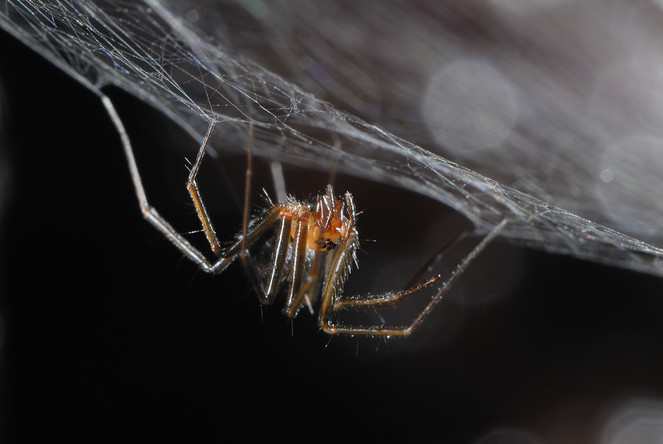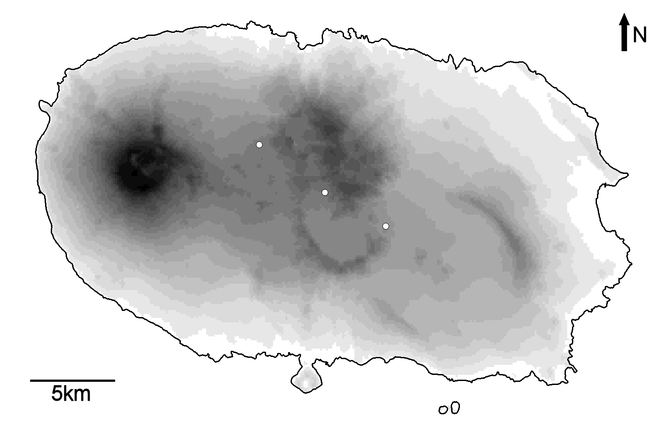|
Biodiversity Data Journal : Species Conservation Profile
|
|
Corresponding author: Paulo Alexandre Vieira Borges (pborges@uac.pt)
Academic editor: Lyubomir Penev
Received: 23 Aug 2016 | Accepted: 30 Aug 2016 | Published: 01 Sep 2016
© 2016 Paulo Alexandre Vieira Borges, Luis Carlos Crespo, Pedro Cardoso.
This is an open access article distributed under the terms of the Creative Commons Attribution License (CC BY 4.0), which permits unrestricted use, distribution, and reproduction in any medium, provided the original author and source are credited.
Citation: Borges P, Crespo L, Cardoso P (2016) Species conservation profile of the cave spider Turinyphia cavernicola (Araneae, Linyphiidae) from Terceira Island, Azores, Portugal. Biodiversity Data Journal 4: e10274. doi: 10.3897/BDJ.4.e10274
|

|
Abstract
Turinyphia cavernicola Wunderlich, 2008 is one of the two endemic cavernicolous spiders known from the Azorean archipelago (Portugal). In spite of relatively intensive searches, this species is known from only three caves, but with a single sustainable subpopulation restricted to the Algar do Carvão show cave. With an observed extent of occurrence (EOO) of 2 km² and an area of occupancy (AOO) around 0,75 km², it presents a restricted range, severe fragmentation, and continuing decline in EOO, AOO, habitat quality, number of locations and subpopulations caused by the ongoing threat from pasture intensification and tourist activities in the cave systems.
Keywords
Cave species, islands, IUCN, red list, tourism, troglobiont
Species information
Common names
Algar do Carvão cave spider
Taxonomy
| Kingdom | Phylum | Class | Order | Family |
|---|---|---|---|---|
| Animalia | Arthropoda | Arachnida | Araneae | Linyphiidae |
Taxonomic notes
This species was described based on males only. This is a pale spider with long legs and large eyes. Male pedipalpus: tibia with single trichobothrium, paracymbium with tooth-shaped distal hook, embolus basally wide (
Male of Turinyphia cavernicola from Algar do Carvão (Terceira, Azores) (Credit: Paulo Henrique Silva).
- Global
Geographic range
- Palearctic
- Portugal
Basis (narrative)
Range description
This is a single island endemic restricted to the Island of Terceira, Azores, Portugal. The species was originally described from a single cave, the volcanic show pit Algar do Carvão, and later also found in two lava tubes: Gruta da Malha and Furna de Santa Maria, that are located nearby.
New occurences
-
scientificName: Turinyphia cavernicola; kingdom:Animalia; phylum:Arthropoda; class:Arachnida; order:Araneae; family:Linyphiidae; taxonRank:species; vernacularName:Algar do Carvăo cave spider; genus:Turinyphia; specificEpithet:cavernicola; scientificNameAuthorship:Wunderlich, 2008; islandGroup:Azores; island:Terceira; country:Portugal; stateProvince:Azores; municipality:Praia da Vitória; locality:Gruta da Malha; verbatimLatitude:4289017; verbatimLongitude:477951; decimalLatitude:38.749568; decimalLongitude:-27.253739; geodeticDatum:WGS84; coordinateUncertaintyInMeters:10; georeferenceProtocol:GPS; habitat:Cave; individualCount:1; sex:male; lifeStage:adult; recordedBy:Paulo A. V. Borges; identifiedBy:Paulo A.V. Borges; institutionID:University of the Azores; collectionID:Entomoteca Dalberto Teixeira Pombo; basisOfRecord:PreservedSpecimen
-
scientificName: Turinyphia cavernicola; kingdom:Animalia; phylum:Arthropoda; class:Arachnida; order:Araneae; family:Linyphiidae; taxonRank:species; vernacularName:Algar do Carvăo cave spider; genus:Turinyphia; specificEpithet:cavernicola; scientificNameAuthorship:Wunderlich, 2008; islandGroup:Azores; island:Terceira; country:Portugal; stateProvince:Azores; municipality:Angra do Heroísmo; locality:Algar do Carvăo; verbatimLatitude:4286675; verbatimLongitude:481200; decimalLatitude:38.728071; decimalLongitude:-27.215393; geodeticDatum:WGS84; coordinateUncertaintyInMeters:10; georeferenceProtocol:GPS; eventDate:1999-11-19; habitat:Cave; individualCount:1; sex:male; lifeStage:adult; recordedBy:Fernando Pereira, P.A.V.Borges; identifiedBy:Paulo A.V. Borges; institutionID:University of the Azores; collectionID:Entomoteca Dalberto Teixeira Pombo; basisOfRecord:PreservedSpecimen
-
scientificName: Turinyphia cavernicola; kingdom:Animalia; phylum:Arthropoda; class:Arachnida; order:Araneae; family:Linyphiidae; taxonRank:species; vernacularName:Algar do Carvăo cave spider; genus:Turinyphia; specificEpithet:cavernicola; scientificNameAuthorship:Wunderlich, 2008; islandGroup:Azores; island:Terceira; country:Portugal; stateProvince:Azores; municipality:Angra do Heroísmo; locality:Furna de Santa Maria; verbatimLatitude:4285000; verbatimLongitude:484200; decimalLatitude:38.713502; decimalLongitude:-27.181735; geodeticDatum:WGS84; coordinateUncertaintyInMeters:10; georeferenceProtocol:GPS; habitat:Cave; individualCount:1; sex:male; lifeStage:adult; recordedBy:Isabel Amorim, Fernando Pereira; identifiedBy:Paulo A.V. Borges; institutionID:University of the Azores; collectionID:Entomoteca Dalberto Teixeira Pombo; basisOfRecord:PreservedSpecimen
-
scientificName: Turinyphia cavernicola; kingdom:Animalia; phylum:Arthropoda; class:Arachnida; order:Araneae; family:Linyphiidae; taxonRank:species; vernacularName:Algar do Carvăo cave spider; genus:Turinyphia; specificEpithet:cavernicola; scientificNameAuthorship:Wunderlich, 2008; islandGroup:Azores; island:Terceira; country:Portugal; stateProvince:Azores; municipality:Angra do Heroísmo; locality:Algar do Carvăo; verbatimLatitude:4286675; verbatimLongitude:481200; decimalLatitude:38.728071; decimalLongitude:-27.215393; geodeticDatum:WGS84; coordinateUncertaintyInMeters:10; georeferenceProtocol:GPS; eventDate:1999-11-19; habitat:Cave; individualCount:8; sex:unknown; lifeStage:Juveniles; recordedBy:Fernando Pereira, P.A.V.Borges; identifiedBy:Paulo A.V. Borges; institutionID:University of the Azores; collectionID:Entomoteca Dalberto Teixeira Pombo; basisOfRecord:PreservedSpecimen
-
scientificName: Turinyphia cavernicola; kingdom:Animalia; phylum:Arthropoda; class:Arachnida; order:Araneae; family:Linyphiidae; taxonRank:species; vernacularName:Algar do Carvăo cave spider; genus:Turinyphia; specificEpithet:cavernicola; scientificNameAuthorship:Wunderlich, 2008; islandGroup:Azores; island:Terceira; country:Portugal; stateProvince:Azores; municipality:Angra do Heroísmo; locality:Algar do Carvăo; verbatimLatitude:4286675; verbatimLongitude:481200; decimalLatitude:38.728071; decimalLongitude:-27.215393; geodeticDatum:WGS84; coordinateUncertaintyInMeters:10; georeferenceProtocol:GPS; eventDate:1999-08-10; habitat:Cave; individualCount:1; sex:unknown; lifeStage:Juveniles; recordedBy:Fernando Pereira, P.A.V.Borges; identifiedBy:Paulo A.V. Borges; institutionID:University of the Azores; collectionID:Entomoteca Dalberto Teixeira Pombo; basisOfRecord:PreservedSpecimen
-
scientificName: Turinyphia cavernicola; kingdom:Animalia; phylum:Arthropoda; class:Arachnida; order:Araneae; family:Linyphiidae; taxonRank:species; vernacularName:Algar do Carvăo cave spider; genus:Turinyphia; specificEpithet:cavernicola; scientificNameAuthorship:Wunderlich, 2008; islandGroup:Azores; island:Terceira; country:Portugal; stateProvince:Azores; municipality:Angra do Heroísmo; locality:Algar do Carvăo; verbatimLatitude:4286675; verbatimLongitude:481200; decimalLatitude:38.728071; decimalLongitude:-27.215393; geodeticDatum:WGS84; coordinateUncertaintyInMeters:10; georeferenceProtocol:GPS; eventDate:1999-12-29; habitat:Cave; individualCount:5; sex:unknown; lifeStage:Juveniles; recordedBy:Fernando Pereira, P.A.V.Borges; identifiedBy:Paulo A.V. Borges; institutionID:University of the Azores; collectionID:Entomoteca Dalberto Teixeira Pombo; basisOfRecord:PreservedSpecimen
Extent of occurrence
Justification for trend
The species is a specialized troglobite living in constant humidity conditions. Many caves in Terceira Island are being impacted by pollution due to the intensive cattle production in the island of Terceira, with the changes in ecological conditions of caves in the last 50 years, namely the change of the N,P abiotic cycles and changes in the water pH (
Area of occupancy
Justification for trend
In Terceira Island there are 15 well-surveyed caves and we found subpopulations in only three. The trend of decline is partly based on the assumption that this species can occur in all these caves and that the absence is due not only to biological reasons (type of cave; age of the lava flow) but mainly to anthropogenic disturbance on caves during the last 50 years. Most of the caves were in the past covered by dense humid native forest, and forest clearence promoted changes in humidity and resource availability in cave environment.
Locations
Justification for number of locations
After a detailed survey of 15 caves in Terceira island the species was only found at Algar do Carvão, Gruta da Malha and Furna de Santa Maria. Each is affected by different threats, mainly touristic pressure in the first and cattle production with consequent deforestation and nutrient input into caves in the latter two.
Justification for trend
After a detailed survey of 15 caves in Terceira island the species was only found at Algar do Carvão, Gruta da Malha and Furna de Santa Maria, which is a small number of locations for a predictably larger range (up to 5 times larger) just 50 years ago.
Population
Justification for trend
Inferred from decrease in AOO and habitat quality.
- (c) a decline in area of occupancy, extent of occurrence and/or quality of habitat
Population Information (Narrative)
Three subpopulations are known in the island, but two of them are very small and located in disturbed lava tubes. The single large subpopulation is located in the show cave Algar do Carvão, which is under intensive pressure due to increasing levels of visitation in the last ten years.
Subpopulations
Justification for trend
The species original distribution was potentially 70 km2, probably including most of the 15 caves surveyed in the Terceira Island, the current range representing a reduction of 93%. However considerable searching efforts around the current caves where the species occurs have failed to find additional subpopulations.
Justification for fragmentation
The large system of lava tubes in Terceira island is fragmented both naturally and artificially. Natural fragmentation is due to the occurence of several independent historical lava-flows in the island. Artificial fragmentation is due to recent destruction of caves for road construction and intensive pasture implementation. Two out of thee subpopulations are considered non-sustainable.
Habitat
Habitat (narrative)
The species is a troglobite specialist occuring only in humid lava tubes and volcanic pits. The sheet webs are built in small holes and crevices in the lateral walls of the caves.
Justification for trend
The intensive cattle production in the island of Terceira increased a lot in the last twenty years and creates high disturbance and pollution in cave systems. This might be the cause for inferred recent reduction in AOO. Touristic pressure might also be a threat in the single show-cave within its geographic range, through reduction in habitat quality.
- 7. Caves and Subterranean Habitats (non-aquatic)
- 7.1. Caves and Subterranean Habitats (non-aquatic) - Caves
Ecology
Ecology and traits (narrative)
The species builds sheet-webs across small holes in volcanic basaltic rock. Usually occurs from twilight conditions near cave openings to deep parts of the caves (
Threats
Threats
- 2. Agriculture & aquaculture
- 2.3. Agriculture & aquaculture - Livestock farming & ranching
- 2.3.2. Agriculture & aquaculture - Livestock farming & ranching - Small-holder grazing, ranching or farming
- 6. Human intrusions & disturbance
- 6.1. Human intrusions & disturbance - Recreational activities
Conservation
Conservation actions
- 1. Land/water protection
- 1.1. Land/water protection - Site/area protection
- 3. Species management
- 3.3. Species management - Species re-introduction
Justification for conservation actions
An area of 40.5ha around Algar do Carvão was classified as “Regional Natural Monument” by the Regional Decree nr 9/2004/A, of March 23rd 2004, due to its unique volcanic features and its environmental importance. Since pasture intensification is one main threat, this might be important to safeguard the species survival in the future and should be extended beyond the current area, possibly allowing the recovery of other caves to original conditions where the species might be reintroduced.
Other
- 3. Monitoring
- 3.1. Monitoring - Population trends
- 3.4. Monitoring - Habitat trends
Acknowledgements
We are indepted to the Speleoplogical NGO "Os Montanheiros" for permits for collecting and long-term support in field work in Terceira Island. In particular Fernando Pereira and Isabel Amorim contributed with samples.
References
-
Spider biodiversity patterns and their conservation in the Azorean archipelago, with descriptions of new species.Systematics and Biodiversity6(2):249‑282. DOI: 10.1017/s1477200008002648
-
Comparison of Bacterial Diversity in Azorean and Hawai'ian Lava Cave Microbial Mats.Geomicrobiology Journal31(3):205‑220. DOI: 10.1080/01490451.2013.777491
-
Using taxonomically unbiased criteria to prioritize resource allocation for oceanic island species conservation.Biodiversity and Conservation19(6):1659‑1682. DOI: 10.1007/s10531-010-9795-z
-
TOP 100 - As cem espécies ameaçadas prioritárias em termos de gestão na região europeia biogeográfica da Macaronésia. [TOP 100- The hundred priority endangered species in terms of management in the biogeographical region of Macaronesia].Consejería de Medio Ambiente y Ordenación Territorial, Gobierno de Canarias,St. Cruz,500pp. [InSpanish and Portuguese]. URL: http://www.azoresbioportal.angra.uac.pt/files/publicacoes_Top100%20Species%20Files.pdf [ISBN84-89729-38-7]
-
Catálogo das cavidades vulcânicas dos Açores (grutas lávicas, algares e grutas de erosão marinha). [Catalogue of the Azorean caves (lava tube caves, volcanic pits, and sea-erosion caves).].Os Montanheiros/GESPEA,Angra do Heroísmo,320pp. [InPortuguese]. URL: http://www.montanheiros.com/publicacoes/grutas/
Supplementary material
Download file (1.37 kb)



